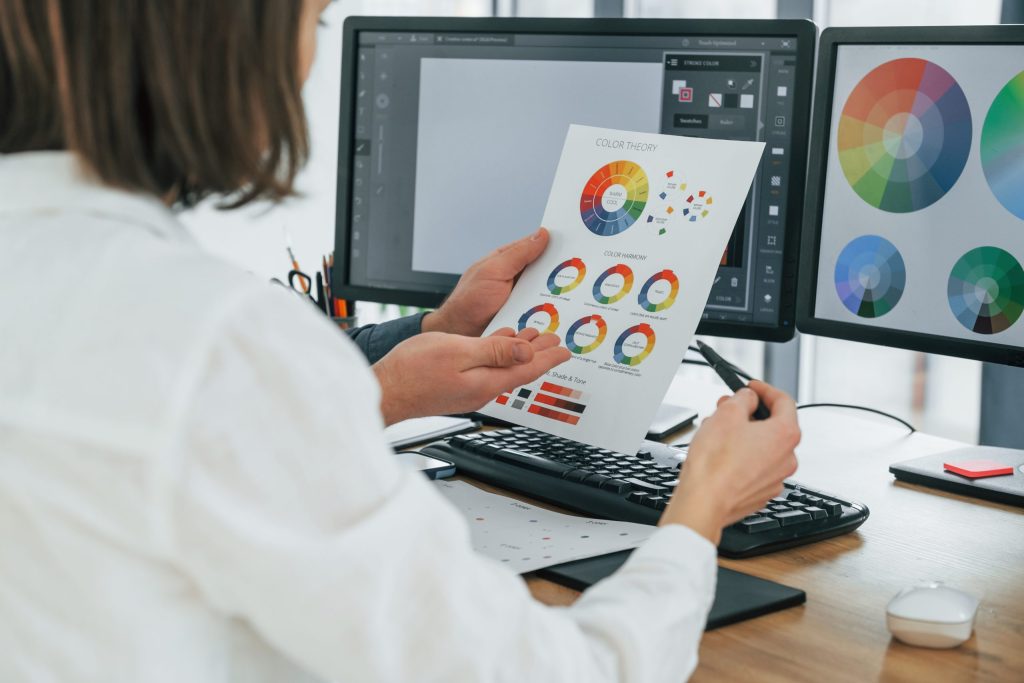How to Start Working as a Computer Graphics Designer?

Table of Contents
We live in an increasingly visual world where compelling graphics capture attention and communicate messages instantly. If you’re drawn to creating visual content that informs, inspires, and engages audiences, a career as a Computer Graphics Designer might be perfect for you.
The demand for skilled Computer Graphics Designers has never been higher. You will have opportunities spanning across industries from tech startups to entertainment giants. Whether you’re a recent graduate exploring creative careers, a professional seeking a career change, or someone looking to turn your artistic passion into a profitable skill, this comprehensive guide will provide you with a clear roadmap to break into this exciting field and build a successful design career.
Why should I consider becoming a computer graphics designer?
Here are the key reasons to consider becoming a Computer Graphics Designer:
- If you are a creative soul who is also intrigued by technology, then becoming a Computer Graphics Designer would combine both worlds for you. This career is where art and science collide. You can experiment with sketches, colors, animations, textures, and so much more.
- The graphic design industry is constantly growing and in high demand. Computer Graphics Designers are needed across various businesses from filming to gaming to app development, etc.
- A career as a Computer Graphics Designer provides you with a lot of flexibility. You can make this your full-time job or as a side hustle. Moreover, you can have your pick of employment options whether you are self-hired, freelance or employment contract. You can find a deal that best suits your needs and lifestyle.
- If you enjoy continuous learning and innovation, graphic design offers constant opportunities for growth. The graphic design field is constantly growing and changing. You need to be a chameleon to adapt and change as the market continues to innovate.
- You can shape how people view things. Your work can inspire, inform, entertain—or even change minds. As the old saying goes “with great power, comes great responsibility”
What does a Computer Graphics Designer do every day?
While every day brings different challenges, Computer Graphics Designers typically handle similar core responsibilities. Your day will be a mix of both creative and technical endeavors. When it comes to the creative aspect, you can expect to design visual content. This visual content can range from logos to social media posts to web/app layouts, and so much more. Now, when it comes to the technical aspect of the job, you will probably find yourself working with software such as Adobe Photoshop, Illustrator, InDesign, Figma, or Blender.
There is another aspect of the day-to-day life of a Computer Graphics Designer that we cannot forget. This aspect involves brainstorming and developing concepts which typically involves collaborating with teams, stakeholders, and other decision makers.
Now, each job also involves some admin work such as managing projects and files. Also, editing or fixing anything that requires improvement is important.
Key Responsibilities
So as a Computer Graphics Designer regardless of whether you are working on print, digital media, or interactive design, here are some responsibilities that will no doubt part of your role:
- You need to understand the project requirements. So, when you meet with the team, clients, stakeholders, etc. You want to make sure you understand goals, brand identity, and target audience. Along with other specifications they may throw at you.
- Another key responsibility is creating visual designs. You need to design the graphics for the project you are working on. This involves developing digital illustrations that will communicate the brand’s message. Also, make sure you stay consistent across all mediums.
- You get to work with Adobe Photoshop, Illustrator, InDesign, Figma, Sketch, or Canva to produce high-quality visuals. Now if you are in a more advanced Computer Graphics Designer role, you may be working with motion graphics tools (After Effects) or 3D software (Blender, Cinema 4D, Maya).
- You need to be able to meet and handle multiple projects and deadlines at the same time. As a Computer Graphics Designer, you will have to prioritize tasks, manage revisions, and deliver final assets on time.
- So, this last one is not a “responsibility” per se, but it’s always nice to see Computer Graphics Designers who stay on top of current trends when it comes to creating visuals. Also, consider experimenting with new techniques, tools, and design styles to stay competitive.
Skills required
Essential skills for Computer Graphics Designers include:
- Creative Skills
- Technical Skills
- Conceptual & Problem-Solving Skills
- Soft skills
- Bonus skills: UI/UX Design, Basic Coding, and AI tools
What Is the Educational Path to Becoming a Computer Graphics Designer?
There are a few educational paths you can take to become a Computer Graphics Designer; one is more formal while the other is gaining popularity and provides greater flexibility.
According to Colorlib, about 68% of Computer Graphics Designers have an academic 4-year degree. However, many successful Computer Graphics Designers have gained knowledge and experience by being self-taught, bootcamps, remote courses, etc.
Do I need an academic degree to be a Computer Graphics Designer?
When considering the academic route to becoming a Computer Graphics Designer, most college degrees take around 4 years. They are stationary courses that require regular attendance and can be expensive. Not to mention, if you are looking to start a new career sooner, rather than later, you may not have 4 years to spend on formal education.
Can I become a creative designer without a university education?
Yes, you can become a creative designer without a university education. Many accredited online graphic design courses are available and can help you land the role of your dreams.
Kemp Center offers a terrific graphic design course that will give you access to experts and the ability to complete the course on any device. Furthermore, you will gain foundations of modern design that will help you start your career off on the right foot. Also, you will learn how to use valuable software such as Photoshop, Illustrator, and InDesign. Not to mention you get access to bonus materials that can serve you throughout your career as a Computer Graphics Designer.

What is the master toolkit a Computer Graphics Designer must have to be successful?
Now, each Computer Graphics Designer needs to have a toolkit that helps him or her create visual design magic. Let’s explore some of the most popular ones that you should consider having in yours:
Adobe Creative Cloud (Photoshop, Illustrator, After Effects)
The Adobe Creative Cloud is one of the most powerful and widely used toolkits for Computer Graphics Designers. It provides many tools in one place for an easy creative workflow.
The Adobe Photoshop software is best used for raster-based image editing, photo manipulation, digital painting, web and UI mockups. Some key features that photoshop offers includes:
- Layer based editing
- Tools for retouching images
- Smart objects for nondestructive editing
- You can integrate with your tablet for drawing and sketching
- Export options.
This tool is very popular for retouching photos, creating digital art, and designing mockups for websites and apps. Also, it is a huge asset in the marketing industry.
Another tool part of the Adobe bundle is Illustrator. This tool is great for vector-based graphics, logos, icons, typography, and scalable illustrations. It provides Computer Graphics Designers with features such as:
- Vector drawing tools
- Advanced typography and text manipulation
- Artboards
- It is integrated with Photoshop and InDesign
- SVG, PDF, EPS, and AI file exports for print and digital uses
This tool is particularly popular for logo and brand designs. Also, you can use it to create infographics, icons, and other illustrative elements. If you are working with print media, you can also use Illustrator to help design business cards or posters.
Finally, we have Adobe After Effects, which is another powerful tool. This is best used for motion graphics, animation, and visual effects (VFX). Some key features of this software include:
- Compositing multiple visual layers.
- Keyframe animation for text, shapes, and 2D/3D assets
- It is also integrated with Photoshop and Illustrator
- Visual effects plugins and scripts for professional results
- You can export video files in various formats
As a Computer Graphics Designer, you may use After Effects to create animated logos and/or brand intros. Also, it can be used to design explainer videos and kinetic typography. Moreover, you can use it for motion UI/UX prototypes. Finally, this tool is excellent for post-video production and special effects.
However, the genius in this toolset is being able to combine all together to create the ultimate workflow. Imagine this you start off your creative journey with your design assets in Illustrator. Then you move on to composite them in Photoshop, so that you can add textures, backgrounds, and effects. Then your final destination is After Effects, where you can animate the final design, to create motion graphics or a presentation.
Blender or Maya (for 3D graphics)
When creating 3D graphics, there are two popular software options Blender vs Maya. Blender is considered to be easier for beginners, as the start of your 3D graphics journey, whereas for many businesses Maya is considered the standard.
Blender is an open-source 3D creation suite that is used for modeling, sculpting, animation, rendering, compositing, and video editing. Blender can be used with a wide range of tools such as physical simulations and procedural workflows.
On the other hand, we have the tool Maya that is a standard among most businesses and is more complex than Blender. Furthermore, Maya is known for it’s uses in the film, television and gaming industry. Maya enables graphic designs to create stunning photorealistic graphics. Also, these visual designs can be made interactive, which is another huge asset.
Sketch, Figma, Canva (for UI/UX and digital design)
Three popular tools for UI/UX and digital design include Sketch, Figma, and Canva. They can also contribute to a computer graphics designer’s toolkit. Let’s explore each of them in a little bit of detail:
- Sketch is a vector-based design tool that is primarily used for UI/UX design, typically by MacOS. It is a great tool for interface design and has a vast ecosystem of plugins to build functionality.
- Figma is a cloud-based UI/UX design tool accessible via web browsers and desktop apps, allowing real-time collaboration among multiple users. It offers cross platform support for Windows, macOS and Linux via browser.
- Canva is a user-friendly online design tool that can be used to create social media posts, presentations, flyers, and simple digital designs. It offers an extensive library of templates, fonts, images, and elements. You can co-collaborate on various design projects, and it is affordable, and even offers a free option.
Top 5 popular career paths in graphic design
Once you complete a computer graphic design course, your career path can develop and flow in one of these 5 popular roles.
UX/UI Designer
“Good design is about making things understandable and enjoyable. It’s not just how it looks, but how it works.” according to Don Norman, the pioneer of User Experience Design. He is also known as the father of UX/UI Design.
UX/UI design is one of the most popular & in demand fields of the graphic design world. This role blends beauty and the brain. As a UX/UI designer, you will create products that people love and use effortlessly. You sit between design, technology, and user behavior.
Some common tasks that you will handle in this role include:
- User research, information architecture, wireframing and prototyping, and finally user testing
- You will also get to create the visual design, make sure it’s consistent with the brand, creative interactive elements, and finally build design systems.
You can expect to land a job at tech companies, startups, and design agencies or studios. Also, you can try working freelance and work contract roles, if that better fits your needs. Now let’s quickly look at salary, here is what you expect at an entry level:
- $60k–$80k in the United States
- £30k–£40k in the United Kingdom
- €40k–€60k across the European Union
These figures can depend on location, experience, company type, specialization, and other compensation elements.
Web Designer
A web designer does more than just create a website that looks good. Web designers are digital architects that create a story and build a brand through the website they have sketched out.
A web designer’s purpose is to craft an engaging, intuitive and eye-catching website that will fascinate the user and drive action. So, they are not just simply creating a landing page or two; there is so much more to it.
Web designers
- Build experiences
- Tell stories
- Connect art and functionality
- They think like the user and design the site so that it’s clear, easy and enjoyable.
Moreover, these experts are in high demand and it’s easy to gain an entry level job to start your career. As a web designer you will most likely connect with marketing teams, developers and decision makers.
According to Glassdoor, in the US an entry level web designer can around ~$4 000/month which is roughly $48 850/year. Now, in the UK, an average entry level web designer can look to bring home around £26K–35K a year. When looking at other European countries you can see rates any from €30k–40k in mid-sized EU cities. However, there is an exception when we look at Germany and the Netherlands, web designers can make €50k–70k+ per year.
Generalist Computer Graphics Designer
Another popular role after learning about computer graphics design is a generalist Computer Graphics Designer. If you are looking to take part in a vast array of projects and not be pushed into a niche, then this role is perfect for you.
As a generalist Computer Graphics Designer, you will be creating digital visuals for various brands and industries. You will be a valuable team player for small teams, agencies, startups, or businesses that need one person to cover various design needs.
The role of generalist Computer Graphics Designer is modernly competitive, but if you are looking to be a freelancer, you may have heaps of clients. Now, if you choose to work for a company, based on your location, your annual salary may look like this:
- United States –> $40,000 – $55,000
- United Kingdom –> £22,000 – £28,000
- Europe –> €24,000 – €35,000
Make sure to build your portfolio from the beginning, as this will help showcase your versatility and land that first job. Also, if you have an understanding of business and marketing, these skills will no doubt help you land a role. Finally, be comfortable speaking with clients, stakeholders and other decision makers.
Publication Designer
A publication designer creates and lays out content for print and digital media. So, you would create layouts for content that goes in magazines, newspapers, books (print & ebooks), catalogs, etc.
You would oversee the following tasks:
- Arranging texts, images, graphics and other visual media to make sure they flow in a balanced way.
- You will choose and manage typography to make sure that the text is readable
- Also, you will work with photos and illustrations whether it be creating them or editing them so that they fit the format of the publication.
- As a publication designer you will ensure that everything is on brand
- You won’t be working alone, you will get to collaborate with editors, writers, photographers, and printers (or developers for digital publications).
- And finally you will prepare the files for production and or print.
In the United States according to Glassdoor as Publication Designer you can make anywhere from $50K–$80K, up to $100K+ at higher levels. Whereas, for the United Kingdom they report £25K–£40K; in London and mid-senior roles, often £35K–£50K. When looking at Western Europe for publication designers, €35K–€55K for mid-level; €60K+ in large cities or senior roles.
Product Designer
As a product designer you can consider yourself the creative mastermind behind the tools and apps you will use everyday at your job. You are a combination of an artist, a problem solver, and a detective.
Some tools that will be in your toolkit include:
- Figma, Sketch, Adobe XD (for design)
- Notion, FigJam, Miro (for ideas and collaboration)
- You may also need to know HTML/CSS or JavaScript knowledge to be able to better communicate with software developers
You can look forward to creating fashion apps, meditation apps, rideshare apps, and so much more. You not only make attractive products but also make sure that they function better.
Now, you’re probably curious what your salary will look like, well according to Indeed, in the USA on average you can expect to make around $124,859/ per year. Now if you are working in the UK, you can expect that salary to look more like £40,572/ per year. Lastly, for those of you who are looking within the European Union, your annual salary may look €50k–€70k for entry level and mid-level professionals. But as you gain seniority, you can expect €70k–€100k+ per year.
Why is building a portfolio important in graphic design?
So, when taking part in Kemp Center’s Graphic Design Course, it’s important to start building your portfolio. Your portfolio becomes your identity as a designer. If it’s great, you land great roles. If it’s poor, you may not land that dream job you aspire to.
The Design Guy has been a Computer Graphics Designer for years and his quote, states it best “I now have companies like Meta reaching out to me instead of the other way around.”
A well-crafted, deliberate portfolio was the reason for this change, not by chance. You’re no longer merely applying for jobs when you have the right work on display. Businesses begin approaching you.
So, don’t wait until you have a resume full of experience. Build your portfolio from the beginning, as you are just entering the world of graphic design.
Where to Find Your First Job as a Computer Graphics Designer?
There are several places that you can find your first job in the field of graphic design, some of them include:
- If you are looking for more freelance roles you may consider using platforms such as Fiverr, UpWork or Toptal.
- You can also try various job boards such as AIGA Design Jobs (for the US), Design Jobs Board (for the UK), and Rocket Jobs (for Europe).
- You may also consider checking out platforms like LinkedIn or Indeed.
By taking the Computer Graphics Designer course at Kemp Center and building your portfolio, there is no doubt that you will be able to find a job that suits you.
FAQs (Frequently Asked Questions)
How long does it take to become job-ready?
So, to become ready as a Computer Graphics Designer this can take anywhere from 3 to 6 months, up to 4 years. It depends on if you want to go the remote course route or pursue an academic degree. Also, it’s worth mentioning that during this time you should be putting together a portfolio and be comfortable with various tools. Moreover, they have the knowledge needed to meet with clients and achieve industry standards.
How to Gain Experience as a Computer Graphics Designer Before Landing a Full-Time Job?
There are a few ways that you can gain experience as a Computer Graphics Designer before landing a full time, some of them include:
- Freelance gigs or small projects
- Internships
- Personal projects
- Share your portfolio online
- Network and get feedback from the community
What graphic design software should I learn first?
Here at Kemp Center the first software you will learn during our course is Adobe Creative Cloud, which includes Photoshop, Illustrator and InDesign. You should also try to learn and take an interest in popular software like Figma and Canva.
Also, if you are interested in a specific role as a Computer Graphics Designer, it’s worth looking at various job descriptions to see what tools companies require.
How much can I earn as a beginner Computer Graphics Designer?
So as a beginner Computer Graphics Designer, your salary will vary based on location and industry but to give you some general ideas:
- $35,000 – $50,000 per year in the United States
- £18,000 – £28,000 per year in the United Kingdom
- €25,000 – €40,000 per year in Europe
Also, it’s worth pointing out that tech hubs such as New York, London, Berlin or Singapore, you can expect higher salary even at the entry level.
Summary: Recapping how to start work as a computer graphics designer
Starting your journey as a Computer Graphics Designer involves four essential steps that can transform your creative passion into a thriving career.
- Choose your educational path—whether through a traditional 4-year degree or accelerated online courses like those offered by KEMP Center.
- Master the core toolkit including Adobe Creative Cloud, with Photoshop, Illustrator, and After Effects forming your foundation.
- Build a compelling portfolio from day one, showcasing your versatility across different design disciplines.
- Strategically apply for positions through specialized job boards, freelancing platforms, and networking within the design community.
The graphic design industry offers exceptional flexibility, with entry-level salaries ranging from $35,000-$50,000 annually. You have the potential to work as a freelancer, full-time employee, or specialist in areas like UX/UI design, web design, or product design. With dedicated learning and practice, you can become job-ready in as little as 3-6 months through intensive coursework.
Ready to take the next step in your design journey? Explore our comprehensive Computer Graphics Design Course to master the skills and tools covered in this guide and discover how KEMP Center can accelerate your path to becoming a professional Computer Graphics Designer.


